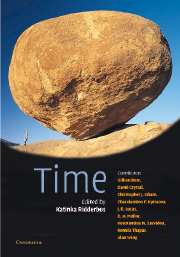2 - Cyclic and Linear Time in Early India
Published online by Cambridge University Press: 21 October 2009
Summary
Introduction
The received wisdom of the past 200 years describes the traditional Indian concept of time as cyclic, excluding all other forms and incorporating an endless repetition of cycles. This was in contrast to what was perceived as the essentially linear time of European civilisation. Implicit in this statement is also an insistence that cyclic time precludes a sense of history, a view which contributed to the theory that Indian civilisation was ahistorical. Historical consciousness it was said, required time to be linear, and to move like an arrow linking the beginning to a final eschatological end. Concepts of time and a sense of history were thus interwoven.
Early European scholars working on India searched for histories of India from Sanskrit sources but were unable to discover what they recognised as histories. The exception was said to be Kalhana's Rajatarangini, a history of Kashmir written in the 12th century. It is indeed a most impressive pre-modern history of a region, but it is not an isolated example, since this genre finds expression in other regional chronicles, even if the others were not so impressive. These others were ignored, perhaps because they were less known to European scholarship; perhaps because if Indian civilisation were to be characterised by an absence of history it would become all the more necessary that Indian history be ‘discovered’ through the research of scholars who came to be labelled as Orientalists.
- Type
- Chapter
- Information
- Time , pp. 27 - 45Publisher: Cambridge University PressPrint publication year: 2002
- 4
- Cited by



